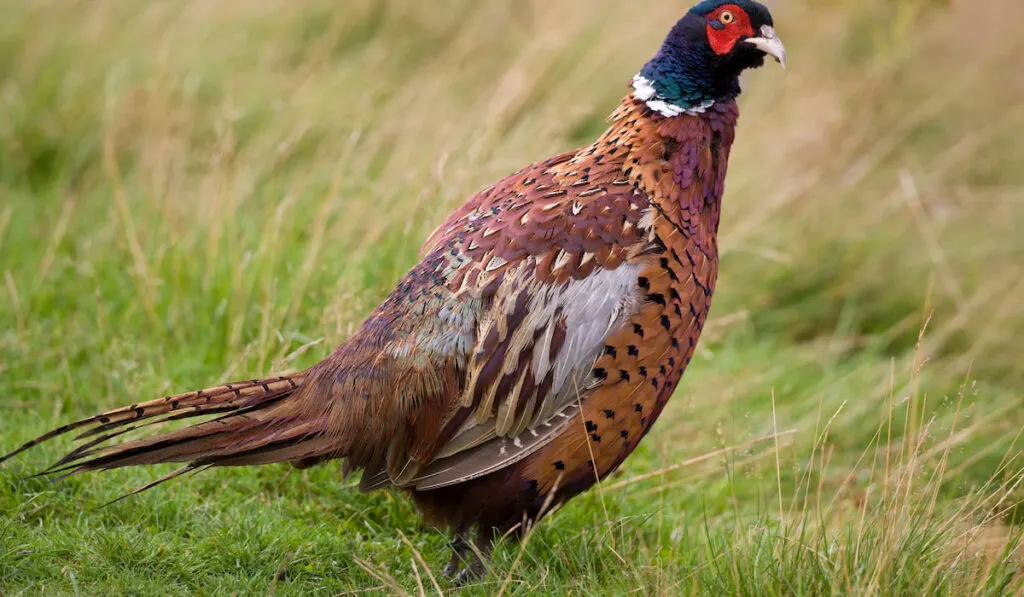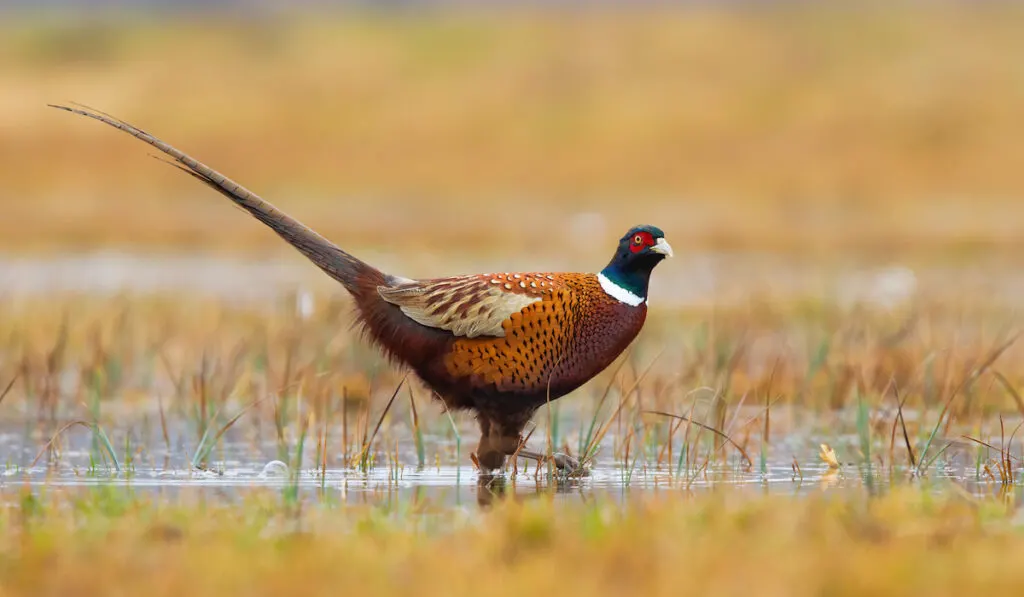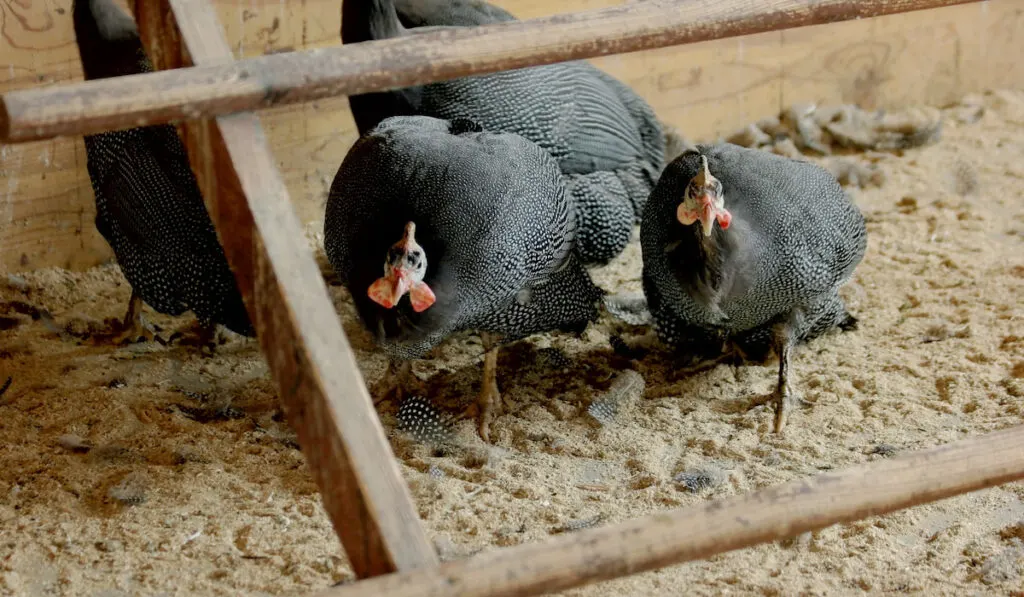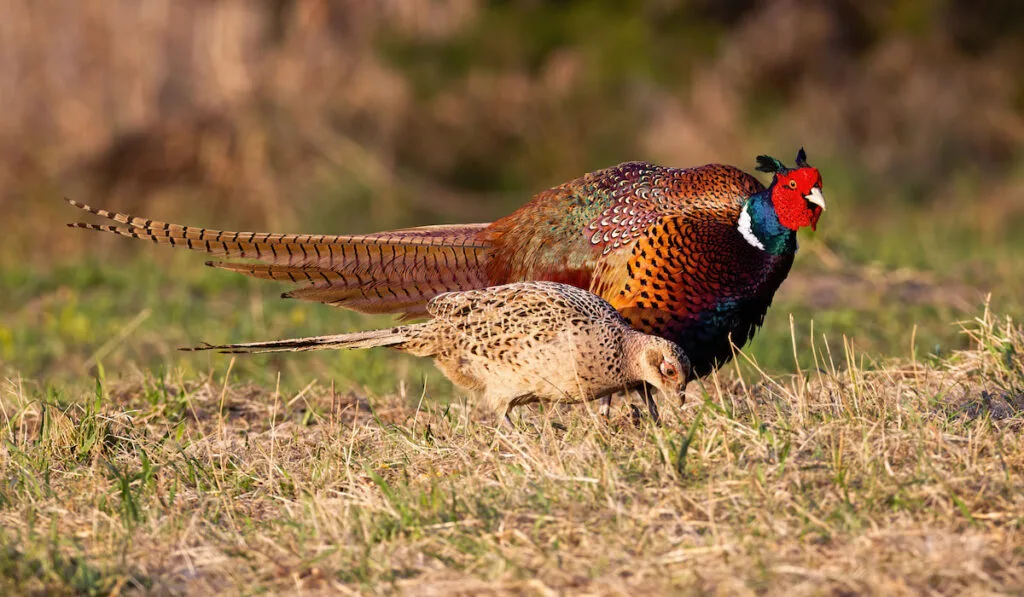Raising pheasants is a rewarding experience when done correctly. There are a few reasons you may consider adding pheasants to your flock. For example, raising pheasants is a profitable business as game birds are in high demand.
To start raising pheasants, you can buy pheasant chicks or adult pheasants to use as breeders. Buying pheasant chicks is the quickest way to start raising pheasants for profit. Pheasant chicks should stay inside until six or seven weeks old.

Pheasants have specific needs that should be met to survive and thrive. Find out what pheasants need and what you need to do to raise these exquisite birds successfully.
Table of Contents
All About Pheasants
The common pheasant, also called the ring-necked pheasant, is native to China and Asia. Still, they have been introduced in other parts of the world and North America. Ring-necked pheasants have been introduced in 40 of the 50 states in the US.
Pheasants are hunted for sport and meat. Because of their beautiful plumage, some pheasant species are kept as ornamental birds. There are both farm-raised and wild pheasants in the United States.
Males, or roosters, are beautifully colored with blue-green heads, red face wattles, and distinctive white neck rings. Females or hens are plain buff-brown, but both have long, pointed tails.
These beautiful birds are a favorite of game hunters. Thousands of pheasants are harvested every year, but reintroduction and management programs boost populations.
There are four markets for pheasants: gourmet food restaurants, hunting preserves, private individuals who buy live birds for custom slaughter, and individuals who restock birds in the wild.
Pheasants usually nest on the ground, and when they are disturbed, they will fly up. They can fly up to 60 miles per hour but only short distances. When chased, a running pheasant and can run 8 miles per hour.
In the wild, pheasants can be found alone or in small flocks. A mother hen and her brood will typically stay together until early autumn.
Pheasants spend their lives on the ground, rarely ever seen in trees. A wild pheasant’s diet consists of various cereal grains, weed seeds, fruits, and insects. Cereal grains like barley, corn, wheat, and Sudan grass make up over 80 percent of the wild pheasant’s diet.
Pheasant roosters will have a harem of several females during spring mating season. Hens will nest on the ground.
Pheasant Facts
Weight: A rooster ring-necked pheasant can weigh 2 to 3 pounds. The hen can weigh 2 pounds.
Length: The roosters measure 24 to 35 inches long (a rooster’s tail is 20 inches long). Hens are much smaller and have a shorter tail.
Lifespan: In captivity, pheasants can live 11 to 18 years. In the wild, their lifespan is around three years.
Flight Speed: 38-48 mph (but can reach up to 60 mph when scared)
Favorite Foods: Seeds, insects, barley, corn, wheat
Preferred Habitat: Undisturbed grass
Length of Incubation: 23 days
Average Clutch Size: 12 eggs
Main Nest Predators: Fox, raccoon, skunk, feral cats
Main Adult Predators: Human, fox, hawk, owl
How to Raise Pheasants
Housing
The most expensive requirement on a game bird farm is the covered pens. It is crucial to build your game bird pens in such a way as to keep the birds in and predators out. Pheasants, if not kept in a covered pen, will fly away.
Do not build your pen where chickens were previously raised. Chicken diseases can stay in the soil for a long time and can be transmitted to your pheasants.
You should give the birds at least 20 square feet of space per bird. If your pen is overcrowded, cannibalism can become a real problem.
Make sure you provide cover for the birds. Pheasants need a shaded area, so a few natural bushes, roofing material, or snow fencing can provide that.
Build your pen in an area with lots of natural grass and vegetation. If the area where you plan to house the birds has no vegetation, plant some oats or millet.
Connect the netting to the four corners of the pen to stop aerial predators from getting to your birds.
Cover the sides of your pen with netting and a 1″ galvanized mesh wire fence. The four sides of the pen should also be covered with galvanized mesh fence. The mesh fencing should be buried at least 10″ and flared to the outside underground.
Doing this will stop predators from digging under the fence. The mesh fencing should extend up to the sides of the pen to the tops of the posts.
It is also recommended to have a sand base on top of the ground in your pen. This makes cleaning easy and drains well, keeping the pen clean and dry. Build a border around the pen to keep the sand from washing away. Buy the sterilized sand for children’s sandboxes or use builder’s sand. You can add agricultural lime to the sand to absorb odors and prevent bacteria.
Water

If you want to raise healthy pheasants, a good diet along with clean water is a must.
What to Feed
- From week one and up to three weeks, use a pre-starter feed with 28% protein.
- From three to seven weeks, you should use a starter feed with 26% protein.
- From seven to 24 weeks, use can use a grower feed with 20% protein.
- Older than 24 weeks, use maintenance food with 14% protein.
When you cannot find game bird feed locally, buy turkey feed. Do not buy chicken feed. Turkey feed is better for keeping pheasants on a healthy diet if you cannot find food for game birds.
Additionally, you can feed the birds insects, grains, dried mealworms, and green vegetation.
Temperature
Adult fully feathered pheasants can withstand extremely cold temperatures. They will use a lot of energy in colder weather and need continuous access to food.
The pen should have a secure cover from bad weather conditions like snowfall and strong winds. During summer, pheasants will hide in the shaded areas of the pen. Don’t be alarmed when you see the birds panting. Birds pant because they cannot sweat.
De-Worming
Pheasants are affected by three kinds of worms. Worms that affect pheasants are the Caecal, Hair, and Gape worms.
Each of these types of worms affects different parts of the bird and causes different problems. The only way to keep your birds healthy and stop a worm infestation is to worm your pheasants regularly. Worming is necessary if you keep chickens and other fowl on your farm.
Pheasant Breeding Habits
The breeding season for pheasants is usually from April to June. Roosters mate with several hens during the breeding season. Roosters might get aggressive with other birds in the pen, but this will reduce when the hens start to lay their eggs. It is best to keep only one male per species in pen because pheasants are very territorial.
Nesting Habits

Pheasant hens build their nests on the ground. They will construct the nest from vegetation and a few feathers that are found in the area. The nest might be in a natural indent on the ground, or the hen might have scooped it out of the ground. A pheasant’s nest is generally around 3 inches deep and 7 inches across.
Rearing Pheasant Chicks
It is worthwhile to prepare before your chicks arrive home. Pheasant chicks are delicate, and your brooder must be ready all set up correctly, or you might face problems.
Prepare by cleaning and sanitizing the brooder, brooder barns, and outdoor enclosures a few weeks before the chicks come. Provide a heat lamp and large kiln-dried wood chips as bedding.
Pheasants like to eat wood shavings. When chicks have access to wood shavings, they eat them and often die. To stop the chicks from eating the wood shavings, you could use chopped straw as bedding for the pheasant chicks.
Cannibalism is a real issue with pheasants; to avoid cannibalism, provide adequate space and ample feed and waterers throughout the brooder house. The brooder house should provide enough space to allow 3/4 of a square foot per pheasant chick. Do not overcrowd them.
Day 1: When the chicks arrive, dip their beaks in the water. Most deaths occur because the chicks do not start to eat or drink immediately.
Place the chicks under a heat lamp. Heat lamps are the best to use. For every 100 chicks, you should use a heat lamp with a 250-Watt infrared bulb.
Make sure you get a heat lamp with a red end on the bulb; it won’t be too bright and controls cannibalism. You should have the heat lamp hanging from the roof, 18 inches from the floor.
Provide feed and do not allow the water or feed to run out. Use at least one 2-foot-long feeder for every 50 chicks.
Use 1 x one-gallon waterer for every 75 chicks. Try to use a waterer with a narrow lip (1/2 inch or less). If not, add some stones to the water bowl, so the chicks don’t drown.
Feed a 28% game bird pre-starter feed that contains coccidiostat (Amprolium). This feed is the best medicated started to feed. The feed should be in crumble form.
If the chicks are sick, you can add Terramyacin soluble powder (an antibiotic) to their water for the first week. Still, it is not recommended to use an antibiotic unless the chicks are sick.
Week 1: Check on the chicks frequently to make they are warm enough.
Never let your pheasant chicks run out of feed or water. If you want to know if the chicks are warm enough, they should form a circle around the heat lamp. When the chicks bundle together directly under the heat lamp, it shows they are cold, and then you should lower the lamp.
Or add more heat lamps. If the chicks spread out far away and pant, they are too hot; you should turn off one of the heat lamps, raise the heat lamp, or maybe open a window during hot weather.
Inspect your chicks frequently during the first week, particularly at night during the first few nights. Chicks often die from piling when they are too cold during the first or second night.
Week 2: When the chicks are 2 or 3 weeks old, it is a good plan to let the chicks go outside during the daytime. Let them out on sunny days to an outdoor predator-proof run. Late afternoons drive the chicks back into the brooder. The brooder should be large enough to allow 1 – 2 square feet per bird at this age.
Week 3: Daytime, when the birds are out, turn the heat lamp off. Late afternoons turn the heat lamp back on. Turn the heat lamp on at night until the chicks are 3-4 weeks old. At this age, feed a 26% game bird starter with a coccidiostat.
Week 4-5: When the chicks reach 4-5 weeks, they need a bigger pen. Allow 25 square feet per bird in the covered pen.
Week 6- 7: Continue to use a 26% game bird starter with a coccidiostat until the birds are mature.
Week 8-20: At this age, feed 20% game bird grower feed.
Week 20+: At this age, feed 14% game bird maintenance feed.
Cannibalism

Cannibalism is a real problem with raising pheasants. Always be on the lookout for cannibalism. The first evidence you notice will be blood on the wingtips and tails of some of the smaller birds.
Don’t expect this just to go away; instead, it can get worse. Add some branches and alfalfa hay to the pen for the birds to peck at and play on to keep them occupied. You might have to trim the top beaks on your birds to stop the problem.
You can use fingernail clippers, trim the beak far enough back so that it bleeds a little. You can do this as early as two weeks old, and it might have to be repeated later.
Conclusion
Raising pheasants is challenging at times, but if you follow all the tips we posted above, you are sure to raise a successful, profitable brood of pheasants.
Raising pheasants is a constant learning process. However, raising a healthy, well-feathered pheasant to maturity is very rewarding. If you are thinking of trying something new, give raising pheasants a try.
